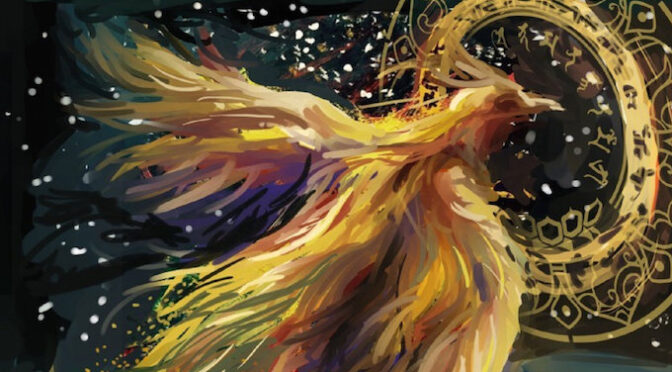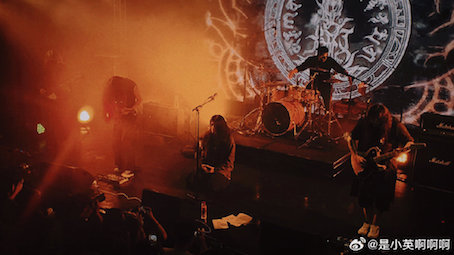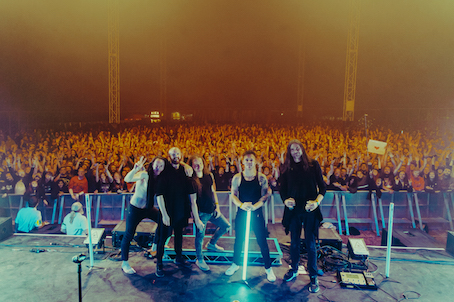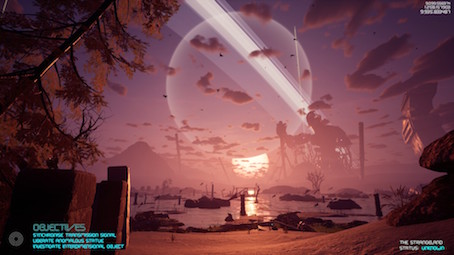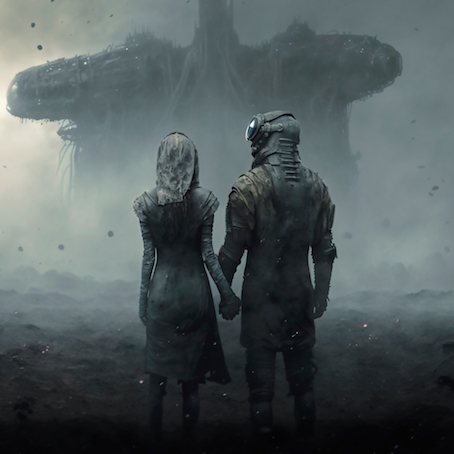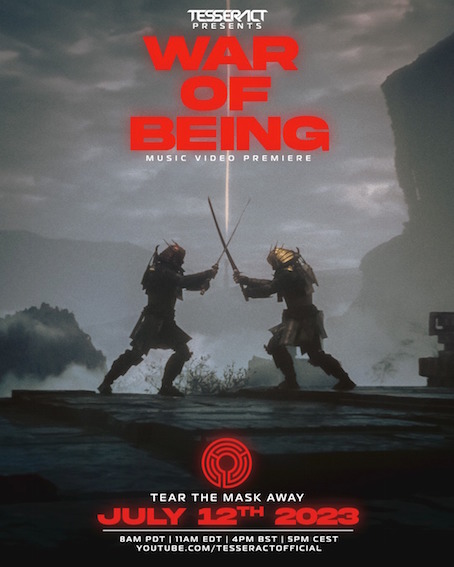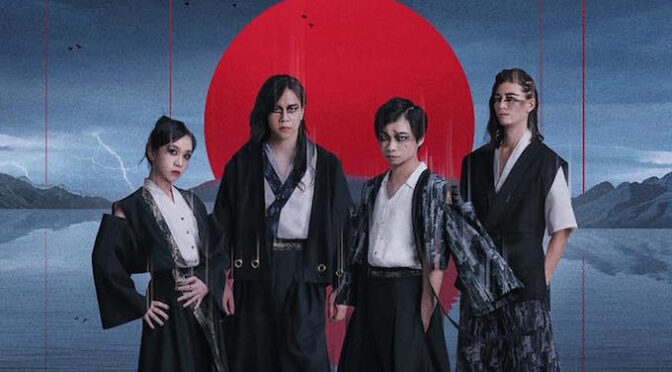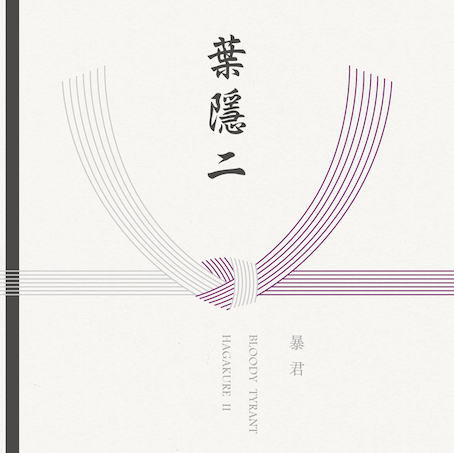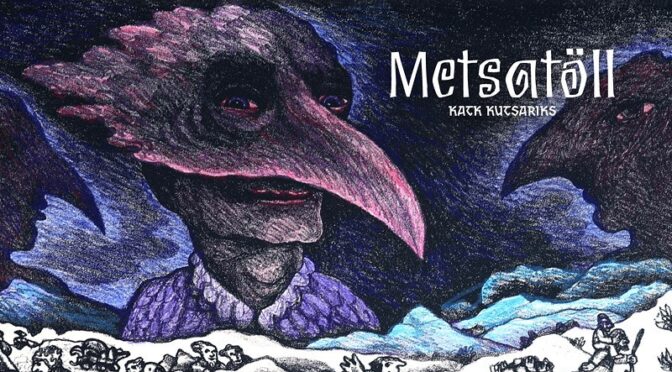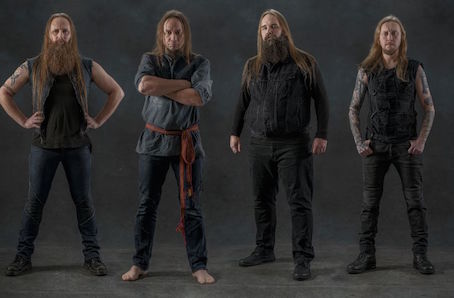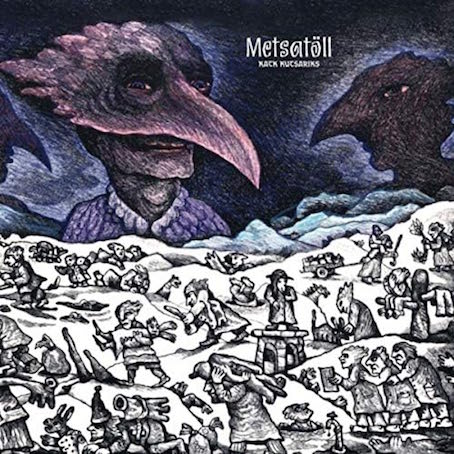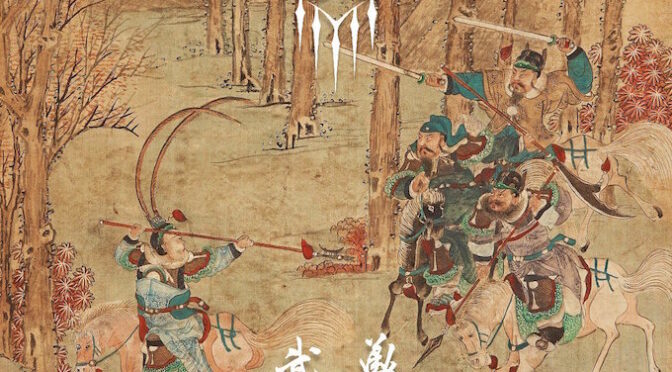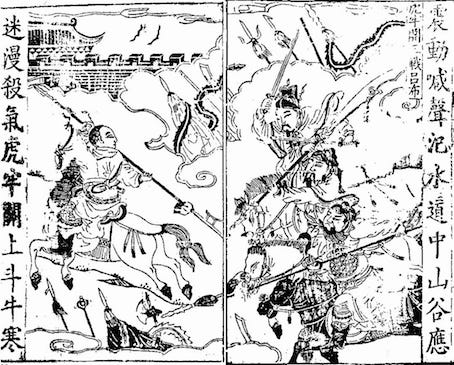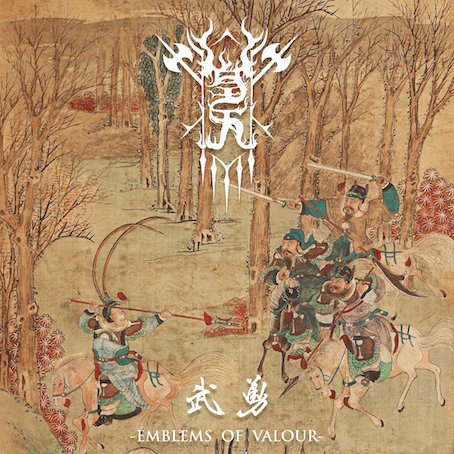EXCLUSIVE: INTERVIEW WITH DRYAD OF 虚极 (BLISS-ILLUSION) !!
“I Personally Believe That Black Metal Is a Very Special Form Of Music, With Themes Given To It By People. I Don’t Care About These Things, I Love Black Metal Very Much, But I Won’t Be Limited To My Love For It.”
DISC REVIEW “森羅万象”
「僕たちの音楽テーマは “雰囲気” という多くの概念を統合したもので、言葉で表現するのは難しいんだ。個人的には、ロマンティックで神秘的な色彩にとても敏感だよ。僕たちの音楽作品に対する理解が固定化されないことを、ただ願っているだけだよ」 以来、TesseracT はフェスティバルのヘッドライナーを務め、世界中をツアーしていますが、彼らの音楽が停滞することはありません。セカンド・アルバム “Altered State” は15分の組曲を含む “プログレッシブ”、”Polaris” は メロディック、そして飾り気のない “Sonder” は “ストレート” というように、彼らの立体は様々な面を際立たせながら回転を続けていたのです。そして今回の “War of Being” に関しては、”包括的” という言葉がシックリとくるのかもしれませんね。 そうして TesseracT 自身の包括的な世界へと旅は超越します。”Legion” は、混沌としていながらも破壊的に構築され、これまでに経験したことのない次元へと浮遊していきます。Dan は、絶叫し、ファルセットを響かせ、リスナーの知らない高みに到達するヴォーカル・パフォーマンスを披露。まさに傑出した瞬間でしょう。 新しいアイデアの登用とともに、”War of Being” でのギターの扱いは試行錯誤の連続でした。Acle は、作曲の過程でも音楽的な体現者であり、アルバムのリフはすべて自分でレコーディングしました。James は、TesseracT の常として、後からパートを学んでいくのです。 最も重要なのは、TesseracT にとって、音楽を作って売るだけではもはや十分でも成功でもないことでしょう。 「ああいうサイクルと自分の理想にギャップを感じ、新たなチャレンジを実現したいと思ったんだ。エキサイティングで、新しいオーディエンスを開拓できるようなことは何だろう?ってね」 このコンセプトは、Dan が Twitch でChatVR を使ってファンのためにパフォーマンスをしていたときに生まれました。そして最終的には、彼のスタジオをバーチャルに再現し、ラウンジや映画館、ライブの体験も呼び起こすマーチャンダイズ・エリアも設置することになりました。そうして “War of Being” のアルバム・コンセプトが進化するにつれ、VR体験のアイデアも自然とまとまっていったのです。 「僕は子供の頃からゲーマーで、サイレント・ヒルやバイオハザード シリーズ全体、さらには DOOM のような一人称シューティングゲームに没頭してきた。素晴らしいビジュアルを伴う美しく雰囲気のある音楽を聴くと、グラフィックが年々向上しているのがわかるし、ゲームは本当にさまざまな意味でインスピレーションを与えてくれるよ。視覚的にも音楽的にも刺激を受け、あらゆる種類の感情やアイデアを呼び起こすことができるから」 曲作りの面では、TesseracT が始まりの場所、ベッドルーム時代から大きく飛躍したわけではありません。Acle はバンドを10代の若者のプロジェクトとしてスタートさせました。当時所属していたバンド、FELLSILENT ではテクニカルすぎるオフ・キルターなメタル・リフを録音し、マイスペースにアップロードしていました。 2010年になると、もはや TesseracT に対するインターネット上の喧騒は無視できないものとなり、バンドはメジャー・レーベルのセンチュリー・メディアにピックアップされます。センチュリー・メディアから “Concealing Fate EP” をリリースした後、”One” 、そして(シンガーの Ashe O’hara が一時的にフロントを務めていた)”Altered State” をリリースします。そして今日、 “Sonder” と “War of Being” の間に5年の空白があるにもかかわらず、5人組は依然として新たな人気を獲得し続けています。彼らは2022年の ArcTanGent フェスティバルのヘッドライナーを務め、1万人を動員し、”War of Being” のビデオは公開から24時間以内に10万回以上視聴され、YouTube のトレンド・タブにまでランクインしたのです。Acle が振り返ります。 How a Metal Band Is Using Gaming to Redefine How We Experience Music GUITAR.COM:Tesseract on why they needed to “come back and make a big statement” 【NEW REALISING MEDIA SHOW】 詳細は後日、しっかり契約内容が決定次第発表いたします! https://t.co/WYkwjadjpI — Hayato Imanishi (@hayatoimanishi) July 12, 2023 「BLOODY TYRANT の新しいラインナップの日本ツアーは今回が初めてだから、日本のファンに新しいタイラントを見てもらうのが待ちきれないよ!個人的には、また明治神宮に行きたいね! 本当に美しい場所だから…」 続きを読む NEW DISC REVIEW + INTERVIEW 【BLOODY TYRANT (暴君) : HAGAKURE Ⅱ】 JAPAN TOUR 23′ 「私はあらゆる文化に敬意を抱いている。特に、自分たちのルーツや先祖に誇りを持ち、自分たちの民族文化に偽りの羞恥心を抱くことなく、あえて自分たちらしくいようとする人々には敬意を抱いている。過激な民族運動に見られるような民族中心主義や、人種中心主義について言っているのではない。自国の文化を尊重することで、たとえ意見が合わなかったり、同じ価値観を共有できなかったりしても、見知らぬ人を尊重することを学ぶのだ」 続きを読む NEW DISC REVIEW + INTERVIEW 【Metsatöll : Katk kutsariks】JAPAN TOUR 23′ 「若いバンドにどんなアドバイスができるかと聞かれたら、俺はいつもこう言うんだ。音楽だけでなく、コンセプトが必要なんだとね。色々な面で注目を集める必要がある。SABATON や POWERWOLF のようにね。何か特別なことをしなければならない。音楽だけではそう簡単にはいかない時代なんだよ」
中国名の虚极とは古代の書物 “道德经”(TaoTeChing)に出てくる言葉で、この言葉は非現実と現実の間に似た状態を表しています。中国・北京出身の虚极(Bliss-Illusion)は、文字通り、現実と非現実の間にあるメタルを奏でているようです。彼らの現実であるアトモスフェリックなポスト・ブラックのサウンドは、エモーショナルで瞑想的、そして純粋に美しいアートです。しかし、それ以上に際立っているのは、彼らの非現実、スピリチュアルなテーマでしょう。仏教的な歌詞の内容、中華的なイメージ、そしてそれらを具現化した音のパレットは暗黒の烙印を押されがちなこのジャンルにおいて、独特の新鮮な風を吹き込んでいます。
「僕は個人的に、ブラックメタルは人によって異なる与えられたテーマを持つ、とても特別な音楽形態だと信じている。つまり、悪魔崇拝とかそんなことはどうでもよくて、僕はブラックメタルをとても愛しているんだよ。でも、その愛に縛られるつもりはないんだ」
原始的なブラックメタルがそのイメージやリリシズムに至るまで、悪魔崇拝を根底に置いていることは否定できない事実でしょう。そして、その背景は Bliss-Illusion のスピリチュアルなアイデンティティとは対極にあるようにも思えます。しかし、彼らはブラックメタルを近年の流れと同調しながら、より自由に、より多様にその神秘性を追求する器として使用しています。
ただし、ブラックメタルと仏教には共通項も存在します。両者には天国と地獄があり、神秘的な生け贄の儀式も存在します。さらに仏教にはサタンに似た “悪魔” 波旬(ボー・シュン)が存在しますがこれは、六道の魔王、六波羅蜜の主、天魔の主、あるいは自己変容の主として様々な苦悩をもたらすもの。こうした共通の概念は、Bliss-Illusion の仏教ブラックメタルにに無限の可能性を与えているのです。つまり、白と黒の表現が違うだけで、核心は不変。
「僕自身は、仏教は宗教ではなく、普遍的な法則であり、非常に賢明な哲学だと信じているんだ。音楽は人が創り出すもので、それは無限なんだ。宇宙よりも広いのは、僕たちの想像力、それだけだからね」
Bliss-Illusion の宇宙には、仏教だけでなく、道教や儒教の哲学も含まれています。ゆえに、ここに伝統的な意味でのブラックメタルは存在しません。しかし、伝統的な中国人の意識に沿った宗教哲学をブラックメタルで表現したいという彼らの熱意、挑戦心こそ、本来ブラックメタルに備わっていた反骨でしょう。そしてその長江の流れのように瞑想的で、悠久で、オリエンタルな彼らの音楽は、まずは欧州から世界へと羽ばたこうとしています。
今回弊誌では、仏教に改宗したボーカリスト Dryad にインタビューを行うことができました。「僕はゲーム機を集める筋金入りのハードコア・プレイヤーなんだ。ブックオフ、ゲオ、スーパーポテトによく行くよ。4歳からゲームをしていて、たくさんのゲーム機を集めているんだ!アタリ、ゲームウォッチ、GB、FC、SFC、N64、NGC、MD、ドリームキャスト、SS、NDS、3DS、PSP、PSV、ワンダースワン、ゲームギア、WiiU、PSなどなどだね!」 どうぞ!!
COVER STORY + NEW DISC REVIEW 【TesseracT : WAR OF BEING】VR GAME FIRST MEETS METAL
COVER STORY : TesseracT “WAR OF BEING”
“There Are a Lot Of Gamers In The Progressive Following We Have And In Metal In General.”
WAR OF BEING

今年、英国プログ・メタルの英雄 TesseracT は突然ギアをトップに入れました。最後のスタジオ・アルバム “Sonder” からはすでに5年が経っていて、ファンはもうあの37分の作品だけでは満たされない体になっていました。誰もが彼らの “声” をもっと聴きたがっていました。
バンドは可能な限り大げさなやり方で戻ってきました。彼らはこの10年間で最長の楽曲、11分に及ぶ “War of Being” をシングルとして発表したのです。同時に、9月にリリースする待望の新作が1時間のコンセプト・アルバムとなること、2024年5月までの全公演を一挙に発表しました。
ギタリストの James Monteith は、TesseracT にはこうしたビッグなカムバックが必要だったと語っています。
「できるだけ大きな形で戻って来て、大きな声明を出す必要があった。長い曲、素晴らしいビデオ、世界中どこでも演奏すること。僕らの旅の次のステージをスタートさせる意思表明が必要だった!」
すでに TesseracT の旅は、充分に波瀾万丈の物語です。2003年、ギタリスト Alec “Acle” Kahney がベッドルームで MESHUGGAH にインスパイアされたリフを刻むところから始まった TesseracT は、今や英国プログ・メタルの金字塔。2011年のデビュー・アルバム “One” は、SikTh や PERIPHERY のシンコペーションとスクリームを踏襲しながらも、メロディックなブレイクとポストロック的なスペーシーさが、その正八胞体サウンドを新たなレベルへと押し上げました。
「”One”, “Altered State”, “Polaris”, “Sonder” を統合しようと意識的に決めたわけではないんだ。でも、全員が同じ部屋にいて、スタジオで生ドラムでレコーディングするという決断は間違いなくあった。ファースト・アルバムでは本物のドラムを使ったけど、1日か2日で急いで録った。このアルバムでは、ジャム、レコーディング、実験に集中するために、1ヵ月という最高の時間があった。するとどういうわけか、どのアルバムにも似たようなサウンドに仕上がったんだ」
リリカルな “War of Being” は、TesseracT 初のロック・オペラです。その物語は、宇宙船 “ザ・ドリーム” が不時着した後、この見知らぬ土地で離れ離れになった2人の人物、エクスとエルを描くもの。2人の探検家は、”ザ・フィアー” という存在に導かれ、内面を見つめ、自分たちの存在そのものに疑問を抱きながら、この隔絶された世界をナビゲートしなければならないのです。
雰囲気のある “Natural Disaster” の冒頭から、 “War Of Being” がリスナーの全神経を集中させる哲音の旅であることが伝わります。Dan の声の豊かで幽玄な重なりは、バンドの技術力と難なく融合し、魅惑的なサウンド体験を生み出していきます。
ソフトでデリケートな “Tender” が静寂のひとときを作り出し、11分に及ぶ巨大なタイトル・トラックがフューチャリスティックなサウンドで耳の穴の奥深くまで探訪。超高速で宇宙船エンタープライズ号からリフが転送されたような “Sacrifice” でアルバムは幕を閉じます。
このアルバムが卓越しているのは、メロディーや親しみやすさを犠牲にすることなく複雑さを提供している点でしょう。”War Of Being” は徹頭徹尾、リスナーを内省的な旅へと誘い、何度でもこの乗り物への扉を開きます。
このロック・オペラは非常にプログレッシブな物語で、Amos が人生において人が経験する内的葛藤のメタファーとしてこのコンセプトを考案しました。ベーシストはまた、アルバムのストーリーを基にした小説を書きたいとも考えています。
「歌詞が複雑でクレイジーであればあるほど、オタクはそれを愛するだろう」
「昔は、すべて耳で聴いていた。でも今は、Acle がとても親切にビデオを送ってくれる。新しいアルバムで一番難しいリフは、面白いことに、”War of Being” の一番最初の部分だった。あのベンドをチューニングから外れないようにするのは本当に難しいんだ!」
Acle は、”War of Being” で信頼する Mayones Setius AK1 の7弦シグネチャーを使用しました。「ある種のギターには魔法がかかっていることがあるんだ。僕にはその魔法の機材があるんだ」
Acle はまた、常に荒々しいポリリズムを扱っていますが、音楽の数学的要素について考えることはほとんどないと言います。
「僕はただグルーヴと流れに身を任せ、それがどう聞こえるかを感じるだけだ。数学的なことが出てくるのは、Jay の脳内で何かがうまくいかず、16分の1ずつ何かを変えなければならないときだけだ。そうなると混乱してしまうんだ。だから、すべて耳で聞いているんだ」
“War of Beingのプロモーションのため、TesseracT のボーカル、Dan Tompkins を含む小規模な開発チームは、アルバムのテーマと連動し、音楽に没入できる一人称視点のSF VR探索ゲームをデザインしました。同じく “War of Being” というタイトルのこのゲームは、Steamでアクセス可能で、VRでも非VRでもプレイできます。
これまで、こうした没入型のゲームと音楽のタイアップはあまり行われてきませんでしたが、TesseracT はさらにプレイを促すため、ゲーム内でシングル “The Grey” をリリースしました。
「音楽を消費してもらうための新しいメディアを作るという意味合いが強い」 と Dan は語っています。
ゲーム “War of Being” は、”What Remains of Edith Finch” のようなナラティブ・アドベンチャー・ゲームのような展開で、探索とパズルに重点が置かれています。プレイヤーは、各レベルに散らばっているバンドの5人のメンバーを探し出し、”The Grey” の全コンポーネントをアンロックしなければなりません。するとプレイヤーは、TesseracT が得意とするキャッチーなリフとグルーヴに溢れた6分間の大曲をフルで聴くことが可能に。斬新なアイデアを、プレイヤーは新鮮な方法によって探求することができるのです。
Dan によれば、TesseracTは伝統的なアルバム・サイクルに不満を感じていたといいます。それはつまり、レコードを書き、ミュージック・ビデオをリリースし、ツアーを行い、またそれを繰り返すというミュージシャンの円環。
ビョークの “Vulnicura VR” は、TesseracT に最も近いパラレル体験かもしれませんが、”War of Being” はそれ以上に従来のビデオゲームのように感じられます。それは偶然ではありません。
「でも、曲を聴くためだけに10時間もプレイさせることで、非ゲーマーをイライラさせたくはなかった。どのタイプの人にも合うようにしたかったんだ。ゲームをしない人たちにも楽しんでもらおうと思っていた」
それが、”War of Being” が1時間ほどで完遂できる、6ドルの商品である大きな理由でしょう。
「バンドの音楽を探求することが大前提だけどね。ゲームを楽しみながらレコードを買うようなもの。だから手頃な値段にしたいんだ」
もちろん、メタル世界は伝統的にゲームとの親和性が高いジャンルです。
「プログレッシブのファンやメタル全般にゲーマーがたくさんいることも知っている。その最良の例の 1 つは、”DOOM” (2016)とミック・ゴードンが作成したサウンドトラックからの反応だ。人々がこの作品にどれほど情熱を注いでいるかがわかるし、この作品のクロスオーバーの可能性も伝わる。これまでにもそれに手を出したバンドは間違いなく他にも存在し、”Hellsinger”(2022)のような音楽ゲームを制作したさまざまなプロジェクトも数多く存在し、マイケル・ジャクソンとムーンウォーカーを制作したときのように80年代にまで遡ることもできる。それでも、バンドが本格的な VR ゲームを制作している例は見つからないよね」
「もし僕たちが、すべてのファンが集えるメタヴァースを最初に作ったバンドのひとつになれたら、素晴らしいことだと思わない?」 そこから、コンセプトは “ゲーム” のアイデアに発展していきました。しかし、経験の浅い開発者にとって、このアイデアを実現するのは至難の業でした。
「僕はこのためにすべてを投げ出した。これを実現することだけに集中し、1年分の収入を失ったんだ。僕は歌手だけどゲーマーで、ゲームを開発した。僕たちは控えめなメタルバンドだ。資金も手段も豊富な SLIPKNOT のようなバンドではないんだよ。だから、僕らにとっては大きなリスクなんだ」
そのリスクは報われたようで、”War of Being” は現在 Steam で Very Positive の評価を得ています。
TesseracT は、より多くの視聴者に対応するため、非VR版も作成したが、トンプキンスによれば、これにより実質的に作業量は倍増したといいます。
「多くの人はVRを持っていないので、自然とデスクトップに移行していくだろう。僕たちは(VR以外の)体験のレベルを、VRで行っていることに匹敵するように引き上げようとしているんだ。VRは少し小康状態にあり、非常に高価で、まだ成熟途上のメディアだけど、将来、費用対効果が上がり、改善されれば、より多くの人が使いたいと思うようになると感じているよ」
“War of Being” はどのようにプレイするにしても、その広大なレベルと没入感のあるデザインのおかげで、随所に陰謀が散りばめられ、注意を払うことを要求される雰囲気のある体験になっています。
TesseracT は “War of Being” の将来について、ゲームの範囲を拡大する可能性も含めて、大きな計画を持っています。Dan は、いつの日か “大きなインベントリ・システム” を搭載し、プレイヤーが素材を集めて武器やその他のアイテムを作るようになることを望んでいるのです。”ザ・フィアー” はこのゲームの主な敵役で、プレイヤーは最終的にフィアーを倒す必要があります。
「なぜゲームが必要だったのか。それはこのアルバムが、究極の比喩として、知識と恐怖という2人のキャラクターを中心にしているから。フィアーからゲームでマスクを剥がして彼を倒し、知識のロックを解除する必要がある。そしてそれは、人々が真実や人生の真実を受け入れず、知恵や知識に対してオープンでないことの比喩だと思う。多くの場合、人生のさまざまな場面でそれは恐怖によって覆い隠されているが、恐怖を克服することで知識が解放されると感じているんだ。それがこのゲームの大前提だと思うよ」
“War of Being” の将来がどうなるにせよ、Dan は、このゲームを作った経験は “贅沢” であり、音楽産業のルーティンに大胆な発言をする機会となったと胸を張ります。
「人生という存在は多くのカーブボールを投げてくる。僕はもう何年も前のことだけど、警官だったんだ。18歳でノッツ警察に入って8年間。それから初めてレコード契約を結んだから、音楽一筋になるために辞めたんだ。今こそ、最高のものを作る時だ」
ギタリストのアイデアが SNS という駆け出しの領域で注目されるようになると、彼は ENTER SHIKARI のライヴでサポート・バンドとして演奏していた Jay に感銘を受け、彼を引き抜きました。そして、古いラップ・メタルの衣装で FELLSILENT とステージを共にした James とAmos を TesseracT のメンバーに組み込んだのです。James が当時を振り返ります。
「2004年だったんだ。FELLSILENT のサウンドチェックを見て、”なんてこった!これは MESHUGGAH みたいだ!こいつらは最高だ!” って。僕たちは明らかに、あの種の音楽をお互いに楽しんでいたんだ」.
ミルトン・キーンズのプロモーターから Acle を紹介された Dan Tompkins は、2009年にバンドに加わりました。その時点で、TesseracT はすでに先代のヴォーカリスト、Abisola Obasanya とともにアンダーグラウンドで名を馳せていました。2007年のデモには、すでに “One” の楽曲 “Concealing Fate Part I: Acceptance”, “April”, Sunrise” の初期ヴァージョンが収録され、ネット上で口コミで話題となっていたのです。この注目により、バンドはブリティッシュ・メタル界で最高の無名アーティストの1つと呼ばれるようになり、ワシントン・ポスト紙に特集され、2008年には2万人収容のブラッドストック・オープン・エアのセカンド・ステージのヘッドライナーを務めました。
「バンドを始めたときやりたかったのは、フェスティバルで演奏することだけだった。だけどそれ以来、TesseracT はいい意味でゆるやかに成長してきた。Download や Hellfest でいきなり4万人の観客の前に立たされたことはない。
ティーンエイジャーの頃と数十年後とでは、野心は全く違う。誰もが偉大になり、成功したバンドになりたいと思っているが、成功が何を意味するのかよく分かっていないんだ。あのころは、成功とは何かを理解する経験もなく、ただギグを演奏して楽しんでいただけなんだ」
Acle と James は、”War of Being” に求める成功とは、TesseracT の継続的な成長だと話しています。秋から9ヶ月の間に4大陸を回るツアーで、それはすでに実現しているようですが、ある意味 Acle にとって、TesseracT がこれほど大きな存在となることは驚き以外の何者でもないのです。
「僕やろうとしていたのはそんなことじゃない!って時々思うね。当時はただ MESHUGGAH からパクりたかっただけなんだから!」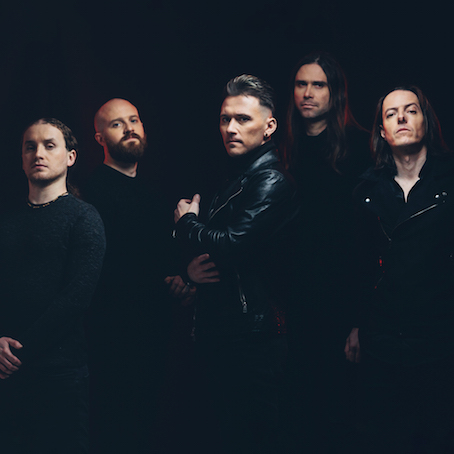
参考文献: GAME OBSERVER :How TesseracT Created Their Own VR Game: Interview with Singer Daniel Tompkins
Tesseract @tesseractband Live in Japan 2024 @ Shibuya Cyclone.NEW DISC REVIEW + INTERVIEW 【BLOODY TYRANT (暴君) : HAGAKURE Ⅱ】 JAPAN TOUR 23′
EXCLUSIVE: INTERVIEW WITH BLOODY TYRANT (暴君) !!
“Retelling Our Root Story Is a Very Important Thing As a Taiwanese Musician. We Have So Many Interesting And Beautiful Stories In This Small island, I Don’t Want These To Be Forgotten.”
DISC REVIEW “HAGAKURE Ⅱ”
3年間の活動休止と大幅なメンバー・チェンジを経て、台湾の BLOODY TYRANT はバンドが不死鳥であることを証明しました。偉大なる Chthonic の後ろ姿を追っていたのも今や昔。シンフォニック・ブラックの皮を徐々に脱ぎ捨てた彼らは、今では独自のエスニックなメロディック・デスメタルで堂々と、欧州の列強たちに挑戦状を叩きつけています。ただし、Chthonic との共通点として、今でも守られているものもあります。それは、台湾の誇りと日本への愛情。そうして彼らは、アジアの “ヴァイキング” として島国の物語を語り継いでいくのです。
「僕の観点では、日本は台湾にとって最も重要な影響力を持つ国で、特に第二次世界大戦中は台湾の軍隊が武士道の影響を多く受けていた。だから、”ここから始めてはどうかな” と考えていたんだよね。戦争が終わって何十年も経った今でも、僕らの日常生活の中に日本の影響を受けたものがあるのを感じるし、武士道が日本人の考え方に少しずつ影響を及ぼしていることも感じるんだ」
最新 EP “Hagakure Ⅱ” は、大名鍋島光茂の家臣であった山本常朝(1659-1719)の回想からなる “葉隠” の物語を締めくくるもの。この写本は150年以上も鍋島家に隠されていた秘伝の書。”武士道といふは死ぬ事と見付けたり” という一節から始まるため、死を賭して君命を果たすと誤解されがちですが、”葉隠” は武士達に死を要求しているのではありません。死の覚悟を不断に持することによって、生死を超えた “自由” の境地に到達し、そうすることで “武士としての職分を落ち度なく全うできる” という意味が込められています。武士として “恥” をかかずに生き抜くための教訓とでも言えるでしょうか。
つまり、死ぬ覚悟さえあれば、生を全うできるという”メメント・モリ” 的な思想でもあるわけです。そうして、血の圧制者、暴君はまさにそこに惹かれました。
「そう、漫画のシグルイに僕は一番影響を受けているよ!そして、シグルイの物語を含む小説、駿河城御前試合。僕たちには、駿河城御前試合の最終章を題材にした “劍士皆亡” という曲があるんだ」
“武士道は死狂ひなり。一人の殺害を数十人して仕かぬるもの”(武士道は死に狂いである。一人を殺すのに数十人がかりでかなわないこともある)を由来とする漫画 “シグルイ”。BLOODY TYRANT がこの物語に感化されたのは、おそらく今の台湾情勢も影響しているでしょうか。中国/台湾の伝統的な撥弦楽器であるピパの音色そのものが持つ魔力は、彼らの音楽に潜む孤独や暗闇を増幅させ、運命に翻弄される台湾という国のメランコリーを引き出していきます。それでも彼らは武士に焦がれます。一騎当千、死の覚悟も厭わない BLOODY TYRANT の面々は、メタルにおいても、政治においても、決して自らの意思を折ることはないのです。
オルガン、オーボエ、チェロ、ヴィオラなどを導入して、台湾の創世をアルバムとした “島嶼神話” のフォーク・メタルはひとつの転機だったでしょうか。島の歴史を知ることは、自分自身を知ることの始まり。歴史を忘れた民族は滅びると歌った彼らの決意も、もちろん武士道の一環に違いないのです。
今回弊誌では、BLOODY TYRANT にインタビューを行うことができました。「台湾は第一列島の真ん中に位置し、非常に複雑な歴史を持ち、隣国から様々な影響を受けている。だから、僕たちのルーツ・ストーリーを語り継ぐことは、台湾のミュージシャンとしてとても重要なことなんだ。この小さな島には、面白くて美しい物語がたくさんあるからね。それを忘れられたままにはしたくないんだ」来日決定!どうぞ!!BLOODY TYRANT “HAGAKURE Ⅱ” : 10/10
NEW DISC REVIEW + INTERVIEW 【Metsatöll : Katk kutsariks】JAPAN TOUR 23′
EXCLUSIVE: INTERVIEW WITH LAURI OUNAPUU OF Metsatöll !!
“By Respecting Our Own Culture, We Also Learn To Respect The Stranger, Even If We Cannot Agree With Them And Don’t Share The Same Values.”
DISC REVIEW “Katk kutsariks”
例えば、私たちはヘヴィ・メタルを愛しているからこそ、メタル以外の音楽も尊重し、リスペクトすることができるのかもしれません。それは、ジャンルこそ違えど、音楽やその文化を愛することがいかに尊く、純粋であるかを知っているから。それはきっと、国籍や人種、宗教においても同じなのではないでしょうか?自らのルーツを愛し、ルーツの尊さを知るからこそ、他者のルーツを尊重できる。自国は常に “正義” で、他国は “悪” なのでしょうか? そんなはずはないでしょう? 他者やそのルーツに対する “寛容さ” があまりにも必要とされている現代社会において、フォーク・メタルは、自身はもちろん、他者の文化や民族を尊重するための完璧なツールなのかも知れませんね。
「エストニア人も日本人も、多くの同じものを見ていることは確かだ。小国に対する西洋文化の圧力がますます強まっているにもかかわらず、私たちの文化にはかなり古い世界観が残されていて、それは “非二元的” な世界観に反映されている。すべては観察者の視点と現象の解釈次第であり、その本質は果てしない否定主義や肯定主義に囚われることなく、ヒーローもアンチヒーローもなく、完全な善も悪も、白も黒もない。非二元的な世界観、伝統や神話を愛し、物語を語ることは、間違いなくエストニアと日本の文化を結びつけるものだよ」
そもそも、江戸時代、日本で “勧善懲悪” が好まれるようになったのは、幕府が物事を単純化して人民を統治しやすくためだったという説もありますが、たしかに古事記を紐解けばイザナキとイザナミの兄妹婚や神なのにやたらと人間臭いスサノヲノミコト、コノハナサクヤビメの一夜孕みなど、タブーを積極的に扱うことで、世界は白か黒か、善か悪かに単純には割り切れないことを示していたような節があります。そして、世界中の神話の中には、そうしてタブーを扱った話が決して少なくはないのです。エストニアの伝承や神話、伝統音楽をメタルに結んだ Metsatöll は、かくしてフォーク・メタルを哲学していきます。
「ここでいうフォーク・メタルとは民族の音楽言語を使うフォーク・メタルで、民族楽器、民謡、母語を使う。中世的なロマンチックな衣装を身にまとい、ギター・リフの合間に映画音楽にインスパイアされたメロディーを奏でる “フォーク・メタル” もクールで良い音楽であることは間違いないが、あれはただのメタル・ミュージックだ。 自分の民族のルーツが何なのか、先祖の文化や音楽が何だったのかを知ることは重要だ。ルーツにはすごい力がある。少なくとも私にとっては、民族楽器を演奏するときに重要なのは、その楽器を演奏することだけでなく、その楽器の歴史、その楽器の音色、歴史的にどのように演奏されてきたのか、そしてその楽器がおそらくどこから来たのかを知ることだと思う」
フォーク・メタルの哲学者、森の賢人 “狼” の異名を持つ Metsatöll は、90年代から活動を続け、シーンの酸いも甘いも噛み締めてきた歴戦の勇者。だからこそ、BLOODYWOOD や THE HU の大ブレイクで活気付くフォーク・メタルの台頭にも、一つの願いを覗かせます。それはルーツを愛すること。ルーツを愛し、文化を愛し、歴史を愛し、言語を愛した真の “フォーク・メタル” だからこそ、強く、寛容になれる。
エストニアは、長年の占領と抑圧、ソ連崩壊とそれに続くグローバリゼーション、資本主義、物質主義がもたらした価値観の変化によって引き起こされた文化的トラウマを抱えてそれでも、ITや学問の分野で台頭し、力強く生き延びてきました。強いだけでも、優しいだけでもない、非二元論の “誇り” が彼らを支えたとすれば、Metsatöll の音楽にはまさしくその誇りが見事に宿っています。呪術的で重苦しく、リズムの迷宮にあって、しかしどこか牧歌的で、歌える生命力にみちた秘宝。それはきっと、”側” だけをドラマティックに仕立てた偽のフォーク・メタルにはないものなのかもしれませんね。
今回弊誌では、Lauri “Varulven” Õunapuu にインタビューを行うことができました。「私はスタジオジブリ、特に宮崎駿の作品に感銘を受けてきた。”猫の恩返し”、”千と千尋の神隠し”、”紅の豚” が子供向けか大人向けかは議論の余地があるが、彼らが扱うテーマや世界を反映する方法は時代を超越していて、典型的なハリウッドの世界よりも人間の本質をより明確に表現していることは間違いない。芸術は問いを投げかけ、問いは人々に考えさせるものでなければならない」エストニア大統領にも賞賛させる国民的バンドの来日が決定。どうぞ!!Metsatöll “Katk kutsariks” : 10/10
NEW DISC REVIEW + INTERVIEW 【WELKIN : 武勇】
EXCLUSIVE: INTERVIEW WITH HASTHUR OF WELKIN !!
“I Was Struck With Incredibly Profound Emotion. It Was Probably Then That I Was Fully Set On Dedicating This Album To The Three Kingdoms Period, And More Specifically, To The Brothers Of Liu Bei, Guan Yu, and Zhang Fei.”
DISC REVIEW “武勇”
メタル世界の大御所 Udo Dirkschneider の言葉です。そしておそらくそれは、正鵠を得ています。無料でワンクリックで膨大な音楽が聴ける時代です。溢れかえる音の宇宙から見つけてもらうためには、素晴らしい音楽を作るだけではもうダメなのかもしれませんね。ただし、いかにコンセプトが優れていても、音楽が魅力的なものでなければ本末転倒。もしくは、例え音楽が素晴らしいものでも、コンセプトが陳腐なものであればやはり長続きはしないでしょう。シンガポールから登場した三国志のブラックメタル WELKIN は、明らかにその両者を抱擁した2023年の完璧なメタル・モデルケースでしょう。
「関羽の忠義に僕は信じられないほど深い感動に襲われ、ふとしたひらめきで、タイトル曲の最後のリフ(9分18秒の “Emblems of Valour”)が僕の前に姿を現したんだ。このアルバムを三国時代、特に劉備、関羽、張飛の兄弟に捧げようと完全に心に決めたのは、おそらくその時だったな」
中国名で “皇天” の名を抱く WELKIN の首謀者 Hasthur は、1800年も昔の中国の物語に、今ではは失われてしまった人と人の絆を見出します。デジタルの世界では、ただボタンを押すだけで手元に品々が届けられ、ワンクリックで誰かとつながることも可能です。しかし、Hasthur はその “絆” に疑問を感じています。テクノロジーの盲信的な進化によって、人は他者や自然を軽んじる、私利私欲のためにそこからただ搾取するのみの存在となってしまった。本来の “絆” とは、物質的な利害を超えた “自由” な関係ではないか?劉備も関羽も張飛も、決して利害で動いていたわけではありません。彼らはただ、”自由” に互いに惚れあって、”自由” に己を捧げあっていたのです。
「”除邪” のアートワークは清朝時代の絵画集 “謹遵聖諭辟邪全圖”(悪を祓う勅令に従え)なんだ。この場合の “悪” とはキリスト教のこと。この解放の本質は、自己克服と奴隷道徳の完全否定だ」
そうして Hasthur が三国志の絆を描くためにブラックメタルを選んだのには、確固たる理由がありました。中国に出自を持つシンガポール人の Hasthur は、清朝時代に “侵略者” であった西欧列強とキリスト教を “悪” と捉え、”奴隷化” されたアジアの人々が西洋の物質文化やキリスト教から解放されることを、ブラックメタルという “西洋” の入れ物で願ったのです。皮肉にも、キリスト教を “敵” と捉える点で、二者のベクトルは同じ方向を向いていました。そう考えると、”ブラックメタルと悪魔崇拝の結びつきは、本質的なものというよりはむしろ美的なものである” という Hasthur の言葉には、真実味が増してきます。逆に言えば、Hasthur が “イカれた共産主義” と嫌悪する現中国政府も、彼にとってはキリスト教と同様のものなのかもしれませんね。
「ジャンルの枠にとらわれない要素を意識的に取り入れる場合、”これは適切なのか?それとも、ただエキゾチックに聞こえるからXを加えたいだけなのか?” と自問しなければならない。民族楽器や民族メロディ、あるいは確立された文化に関連するものの場合、この問いに対する答えが、真にユニークな作曲と、還元主義的なオリエンタリズム/オクシデンタリズム/自分自身をバカにすることとの分かれ目となる」
もちろん、Hasthur のブラックメタルにあるオリエンタリズムは決して陳腐なものではありません。むしろ、そこにあるべくしてあったもの。WELKIN が目指す独自の道筋。その音楽はタイトなプロダクションをベースにさらに成熟し、ロマンティックに”武勇” と共に挑戦し、雄叫びをあげながら真の東洋ブラックメタルの壮大さで遠い過去の戦場の炎と栄光を呼び起こしていきます。音に刻まれし悠久。歴史から、ブラックメタルから、我々は何を学べるでしょうか?
今回弊誌では、Hasthur にインタビューを行うことができました。「偉大なる三島由紀夫 (注: 三島もニヒリズムに傾倒した作家) の言葉を借りよう。”自分を超越した価値を見出すことができなければ、精神的な意味での人生そのものが無意味になってしまう”」 インペリアル・ブラックメタルの飛翔。どうぞ!!WELKIN “武勇” : 10/10

